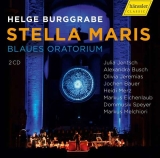 Helge Burggrabe: Stella Maris - Blaues Oratorium; Julia Jentsch, Erzählerin, Alexandra Busch, Olivia Jeremias, Markus Eichenlaub, Dommusik Speyer, Markus Melchiori; 2 CDs Hänssler HC 19021; Aufnahme 2018, Veröffentlichung 17/01/2020 (94') – Rezension von Norbert Tischer
Helge Burggrabe: Stella Maris - Blaues Oratorium; Julia Jentsch, Erzählerin, Alexandra Busch, Olivia Jeremias, Markus Eichenlaub, Dommusik Speyer, Markus Melchiori; 2 CDs Hänssler HC 19021; Aufnahme 2018, Veröffentlichung 17/01/2020 (94') – Rezension von Norbert Tischer
Das für die 1000-Jahr-Feier der Kathedrale von Chartres komponierte und dort 2006 auch uraufgeführte Oratorium Stella Maris von Helge Burggrabe (*1973) wurde für diese Aufnahme 2018 im Dom zu Speyer aufgenommen. Inspiriert von der Farbgebung der Fenster in Chartres trägt es zusätzlich die Bezeichnung Blaues Oratorium. Stella Maris (Stern des Meeres) dreht sich um die Frauenfiguren Maria und Sophia. Der Erzählstrang folgt dem Marienleben und hat eine zweite Erzählebene für Sophia. Das Libretto enthält neben Bibelzitaten und Marientexten des Chartreser Gelehrten Fulbert, Texte des Theologen Wolfgang Teichert sowie der Dichter Charles Péguy, Rainer Maria Rilke und Silja Walter.
Die Musik, komponiert für Chor, Erzählerin, Cello, Klarinette, Schlagzeug und Orgel greift zum Teil gregorianische Choräle auf, klingt mitunter sehr esoterisch, reflektiv oder spirituell, schafft aber auch Anklänge an Carl Orff. Eine wesentliche Komponente ist das Reflektive und damit auch die Stille.
Sicher ist das polystilistische Werk, rein musikalisch gesehen, etwas vordergründig auf Wirkung angelegt. Wer sich aber damit abfinden kann, dem wird es anderthalb Stunden weitgehend kontemplativer Musik anbieten, die den Hörer in eine ganz besondere Welt entführt.
Die Aufführung durch das Vokalensemble Dom zu Speyer, des Mädchenchores und der Domsingknaben ist stimmungs- und niveauvoll.
The oratorio Stella Maris by Helge Burggrabe (*1973), composed for the 1000th anniversary of Chartres’ Cathedral and premiered there in 2006, was recorded at the cathedral in Speyer in 2018. Inspired by the colouring of the windows in Chartres, it is also entitled Blue Oratorio. Stella Maris (Star of the Sea) revolves around the female figures Maria and Sophia. The libretto follows the life of Mary and has a second narrative level for Sophia. It contains biblical quotations and texts by the Chartres scholar Fulbert, the theologian Wolfgang Teichert as well as by the poets Charles Péguy, Rainer Maria Rilke and Silja Walter.
The music, composed for choir, narrator, cello, clarinet, percussion and organ, is sometimes sounding very esoteric, reflective or spiritual. It takes up Gregorian chants but also creates echoes of Carl Orff. An essential component is the reflective and thus also the silence.
The polystilistic work is, from a purely musical point of view, somewhat superficially aimed at effect. However, those who can accept this will be offered an hour and a half of largely contemplative music which will take the listener into a very special world.
The quality performance by the vocal ensemble Dom zu Speyer, the girls’ choir and the cathedral boys’ choir is full of atmosphere.






















